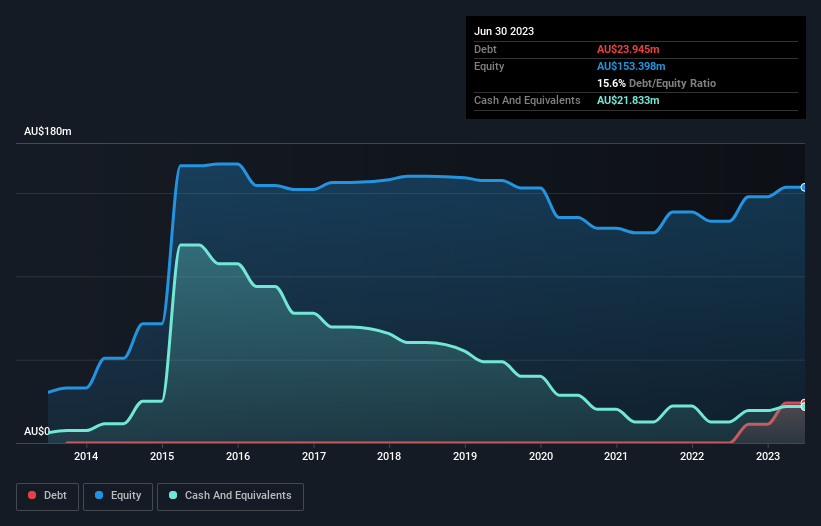Highfield Resources (ASX:HFR) Is Making Moderate Use Of Debt
David Iben put it well when he said, 'Volatility is not a risk we care about. What we care about is avoiding the permanent loss of capital.' When we think about how risky a company is, we always like to look at its use of debt, since debt overload can lead to ruin. We note that Highfield Resources Limited (ASX:HFR) does have debt on its balance sheet. But the real question is whether this debt is making the company risky.
When Is Debt Dangerous?
Debt is a tool to help businesses grow, but if a business is incapable of paying off its lenders, then it exists at their mercy. Part and parcel of capitalism is the process of 'creative destruction' where failed businesses are mercilessly liquidated by their bankers. However, a more usual (but still expensive) situation is where a company must dilute shareholders at a cheap share price simply to get debt under control. Of course, plenty of companies use debt to fund growth, without any negative consequences. When we examine debt levels, we first consider both cash and debt levels, together.
View our latest analysis for Highfield Resources
How Much Debt Does Highfield Resources Carry?
The image below, which you can click on for greater detail, shows that at June 2023 Highfield Resources had debt of AU$23.9m, up from none in one year. However, because it has a cash reserve of AU$21.8m, its net debt is less, at about AU$2.11m.

How Healthy Is Highfield Resources' Balance Sheet?
The latest balance sheet data shows that Highfield Resources had liabilities of AU$9.68m due within a year, and liabilities of AU$26.7m falling due after that. On the other hand, it had cash of AU$21.8m and AU$116.7k worth of receivables due within a year. So it has liabilities totalling AU$14.4m more than its cash and near-term receivables, combined.
Of course, Highfield Resources has a market capitalization of AU$151.0m, so these liabilities are probably manageable. However, we do think it is worth keeping an eye on its balance sheet strength, as it may change over time. Carrying virtually no net debt, Highfield Resources has a very light debt load indeed. When analysing debt levels, the balance sheet is the obvious place to start. But ultimately the future profitability of the business will decide if Highfield Resources can strengthen its balance sheet over time. So if you want to see what the professionals think, you might find this free report on analyst profit forecasts to be interesting.
Given it has no significant operating revenue at the moment, shareholders will be hoping Highfield Resources can make progress and gain better traction for the business, before it runs low on cash.
Caveat Emptor
Over the last twelve months Highfield Resources produced an earnings before interest and tax (EBIT) loss. Indeed, it lost AU$5.4m at the EBIT level. When we look at that and recall the liabilities on its balance sheet, relative to cash, it seems unwise to us for the company to have any debt. So we think its balance sheet is a little strained, though not beyond repair. Another cause for caution is that is bled AU$17m in negative free cash flow over the last twelve months. So suffice it to say we consider the stock very risky. The balance sheet is clearly the area to focus on when you are analysing debt. But ultimately, every company can contain risks that exist outside of the balance sheet. For instance, we've identified 5 warning signs for Highfield Resources (2 are potentially serious) you should be aware of.
At the end of the day, it's often better to focus on companies that are free from net debt. You can access our special list of such companies (all with a track record of profit growth). It's free.
Valuation is complex, but we're here to simplify it.
Discover if Highfield Resources might be undervalued or overvalued with our detailed analysis, featuring fair value estimates, potential risks, dividends, insider trades, and its financial condition.
Access Free AnalysisHave feedback on this article? Concerned about the content? Get in touch with us directly. Alternatively, email editorial-team (at) simplywallst.com.
This article by Simply Wall St is general in nature. We provide commentary based on historical data and analyst forecasts only using an unbiased methodology and our articles are not intended to be financial advice. It does not constitute a recommendation to buy or sell any stock, and does not take account of your objectives, or your financial situation. We aim to bring you long-term focused analysis driven by fundamental data. Note that our analysis may not factor in the latest price-sensitive company announcements or qualitative material. Simply Wall St has no position in any stocks mentioned.
About ASX:HFR
Highfield Resources
Engages in the exploration and development of potash mines in Spain.
Adequate balance sheet with slight risk.
Similar Companies
Market Insights
Community Narratives



